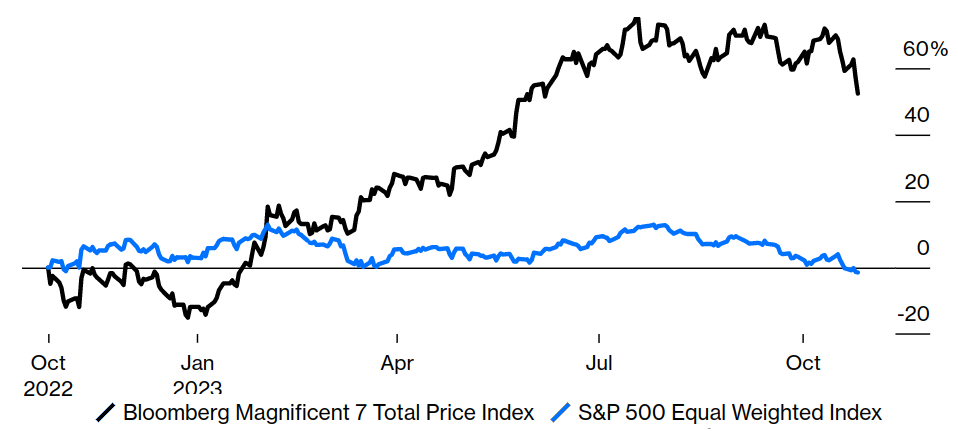The mega-cap tech stocks, which saw a robust start in 2023, are now grappling with massive trillion-dollar losses, leaving their shareholders concerned. Wall Street’s unease over surging bond yields and higher interest rates has cast a shadow on these companies. Traders are now pondering the potential impact on Bitcoin (BTC) if the S&P 500 downtrend continues.
Consequently, investors must investigate the correlation between Bitcoin and the S&P 500 and consider whether cryptocurrencies can thrive in an environment of high-interest rates.
The seven largest tech companies, including Apple, Microsoft, Alphabet, Amazon, Nvidia, Meta and Tesla, collectively constitute a staggering 29% of the S&P 500, marking the highest concentration ever recorded in this stock market index. However, since the end of July, these tech giants have witnessed a substantial erosion in their market value, with a staggering $1.2 trillion loss.
Real Money’s James DePorre notes that “73% of stocks in the market are more than 20% below their highs,” which technically defines a bear market. This underscores growing worries in the broader economy apart from the top-7 stocks.
In its endeavor to regain credibility in combating inflation, the Federal Reserve has indicated its intention to maintain higher interest rates for an extended period. Crescat Capital warns that a significant decline in the S&P 500, coupled with a widening of corporate credit spreads, could elevate the likelihood of an economic downturn.
Higher interest rates impact stocks and commodities
Crescat Capital has also raised concerns about the wave of corporate and sovereign debt maturing in 2024, which will necessitate refinancing at substantially higher interest rates. They recommend exposure to commodities due to their historical resilience during inflationary periods, exacerbated by the challenge faced by commodity producers in investing in fixed assets.
Despite the vast difference in market capitalization, totaling $10.5 trillion for Apple, Microsoft, Google, Meta, Nvidia, and Tesla, compared to cryptocurrencies (excluding stablecoins), which fall short by over 9 times, there are some intriguing parallels.
First, both markets exhibit a scarcity quality that correlates with the monetary base. In essence, both react similarly to the actions of the U.S. Federal Reserve, where increased circulation benefits scarce assets, while a restrictive policy…
Click Here to Read the Full Original Article at Cointelegraph.com News…
























